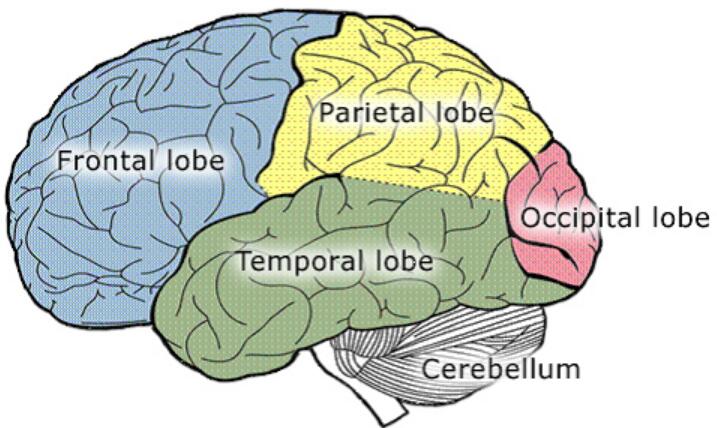The human brain is an incredibly complex and fascinating organ. It is composed of four distinct lobes, each of which serves a unique purpose. Medical experts usually divide the cerebral cortex into four lobes (see image below): frontal, parietal, temporal, and occipital lobes. These functions range from reasoning and language to auditory perception.
This article discussed the four lobes of the brain and their functions. Understanding this information can help you better understand our brains.

Position of Four Lobes of the Brain
The cerebral cortex can be divided into four sections: the frontal, occipital, temporal, and parietal lobes. They have different locations and functions.
The frontal lobe is located in the front part of the brain. It is the largest lobe in healthy human brains. The frontal lobe extends back to a fissure called the central sulcus, which separates the frontal and parietal lobes.
The parietal lobe is located in the middle section of the brain above the occipital lobe and behind the frontal lobe.
The temporal Lobe is located below the parietal and occipital lobes, on the bottom of the brain below the lateral fissure. There are two temporal lobes close to the ears on both sides of the brain.
The occipital lobe is located above the temporal lobe and beneath the parietal lobe. It is located in the cerebral cortex region and sits at the back portion of the brain.
Functions of Lobes of the Brain
1. Frontal lobe
The frontal lobe is the emotional control center of the brain. It can receive information signals from other lobes of the brain. The frontal lobe has many advanced functions in the brain. This lobe is associated with motor skills, cognition, reasoning, expressive language, and regulating social behavior.
In addition, the frontal lobe also contains most of the neurons that are sensitive to dopamine. Dopamine is a neurotransmitter that allows you to feel pleasure, attention, planning, and reward.
Other functions of the frontal lobe include:
- Attention, cognition, and problem-solving
- Language and personality expression
- Planning, reasoning, and judgment
- Concentrate and control attention
- Regulating emotions and impulse control
- Motor skill development and sequencing of complex movements
- Personality expression and social behaviors control
- Predict the consequences of behavior
- Process memory from the limbic system and retain long-term memory
- Impulse control, regulating attention
Since the frontal lobe is located at the front of the skull, it is more likely to be injured than other brain lobes. Damage to the frontal lobe can lead to personality changes, and patients often have difficulty controlling their emotions, sexual impulses, and risk-taking behaviors.
Because the frontal lobe functions to regulate behavior and decision-making, people with damaged frontal lobes may not regulate social behavior normally. In some cases, they are often unable to make the right choice. They may suffer from difficulties with symptoms of ADHD, planning, and problems with executive function.
2. The parietal lobe
Although it is the smallest lobe of the brain, the parietal lobe plays a vital role in sensory perception and integration. The parietal lobe helps integrate sensory information, including pressure, pain, touch, and temperature.
Without the parietal lobe, you can still receive information from your ears, eyes, and other sensory organs. But you might be unable to make sense of the information or its meaning.
Some other functions of the parietal lobe include:
- Touch perception has felt pain, temperature, and pressure
- Identify different objects while touching them
- Visual perception and information processing
- Coordinate eye and hand movements
- Cognition and language processing
- Spatial reasoning as the different regions of the parietal lobe can help “map” other locations.
- Understanding numbers and identifying the relationship between them
Although the parietal lobe is the smallest lobe of the brain, it is essential for information processing. Damage to the parietal lobe can result in language and perception disorders. It may also lead to problems with reading, writing, spatial reasoning, and understanding symbols.
3. The temporal lobe
The temporal Lobe plays a crucial role in auditory processing, including receiving sound signals and processing the meaning of signals.
In addition, the temporal lobe is also responsible for converting short-term memories in the hippocampus and amygdala into long-term memories and processing new information with them.
There are some other functions of the temporal lobe include:
- Recognizing language, including understanding and interpreting the language
- Regulating unconscious emotional
- Process and store visual memories
- Assigning meaning to visuals, smells, sounds, and memories
- Maintain homeostases, such as temperature and heart rate
Temporal lobe damage can lead to obstacles to understanding and production of language. Some injuries can also cause difficulty processing visual perception, long-term memory problems, and personality changes.
4. The occipital lobe
The occipital lobe is the brain’s processing hub for visual information processing. The study found that visual processing is the most significant function of the occipital lobe.
There are some other functions of the occipital lobe include:
- Visual and navigation processing
- Motion, location, and spatial perception
- Color recognition
The occipital lobe is usually not easily damaged due to the skull’s protection. However, in some cases, occipital lobe damage can cause various visual problems, including hallucinations, inability to recognize colors, and difficulty understanding language. Even if the eyes and related nerves are intact in severe cases, damage to the occipital lobe may cause blindness.
5. The limbic lobe
Although some textbooks refer to the limbic lobe as a unique brain lobe, many medical experts still regard it as a group of organs that intersect with various brain regions. The limbic lobe surrounded the thalamus and was located deep in the brain.
The limbic lobe is an evolutionarily older part of the brain that manages instinctive and unconscious emotions. It can collect information from the environment and send signals to the brain to help the brain process emotions.
In addition, the limbic system also contains many sub-organs, such as the hippocampus and amygdala. They are usually related to the function of the endocrine system. Therefore, the emotional response affecting the limbic system can also cause abnormalities in other body parts.
Other functions of the limbic lobes include:
- Coordinate spatial memory and social skills
- Deal with memory fragments
- Regulates attention and mood
- Coordinate the body’s emergency response
- Regulate appetite and libido
Injuries to the marginal lobes can cause functional diseases in other body parts, requiring a detailed diagnosis.
How the Lobes Work Together
While each lobe of the brain has its own specific functions, they do not work in isolation. Instead, the lobes work together to create our perception of the world around us.
For example, when we see a ball rolling towards us, our occipital lobe processes the visual information of the ball’s shape, color, and motion. Then, our parietal lobe helps us judge the ball’s trajectory and calculate the distance between us and the ball. Finally, our frontal lobe tells us to move out of the way to avoid getting hit.
Similarly, when we hear a song, our temporal lobe processes the sounds, while our frontal lobe interprets the emotions conveyed by the lyrics. When we taste food, our parietal lobe identifies the flavor, while our frontal lobe helps us determine if we like it or not.
FAQs
Can people live with damage to a lobe of their brain?
Yes, people can live with damage to a lobe of their brain. However, the extent and type of damage will determine the impact on their daily life.
Can lobes of the brain regenerate after injury?
While some areas of the brain can regenerate to a certain extent, the lobes of the brain do not typically regenerate after injury.
Can one lobe of the brain compensate for damage to another lobe?
In some cases, other areas of the brain can compensate for damage to a lobe, but this depends on the extent and type of damage.
Are some people born with certain lobes of the brain smaller or larger?
Yes, there can be natural variations in the size and shape of the lobes of the brain between individuals.
Can activities like meditation and exercise affect the development of the brain’s lobes?
Yes, research has shown that activities like meditation and exercise can affect the development and function of the brain’s lobes.






